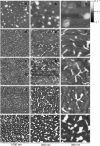Substrate chemistry-dependent conformations of single laminin molecules on polymer surfaces are revealed by the phase signal of atomic force microscopy
- PMID: 17416620
- PMCID: PMC1914422
- DOI: 10.1529/biophysj.106.102491
Substrate chemistry-dependent conformations of single laminin molecules on polymer surfaces are revealed by the phase signal of atomic force microscopy
Abstract
The conformation of single laminin molecules adsorbed on synthetic substrates is directly observed making use of the phase magnitude in tapping mode atomic force microscopy (AFM). With AFM, it is not possible to differentiate the proteins on the substrate if use is made of the height signal, since the roughness of the material becomes of the same order of magnitude as the adsorbed protein, typically 10 nm height. This work shows how AFM can be exploited to reveal protein conformation on polymer materials. Different laminin morphologies are observed on a series of different copolymers based on ethyl acrylate and hydroxyethyl acrylate as a function of the surface density of -OH groups: from globular to completely extended morphologies of the protein molecules are obtained, and the onset of laminin network formation on some substrates can be clearly identified. The results stress the importance of the underlying synthetic substrate's surface chemistry for the biofunctional conformation of adsorbed proteins.
Figures




Similar articles
-
Arrangement of type IV collagen and laminin on substrates with controlled density of -OH groups.Tissue Eng Part A. 2011 Sep;17(17-18):2245-57. doi: 10.1089/ten.TEA.2010.0713. Epub 2011 Jun 20. Tissue Eng Part A. 2011. PMID: 21542695
-
Large area protein nanopatterning for biological applications.Nano Lett. 2006 Jun;6(6):1165-71. doi: 10.1021/nl060403i. Nano Lett. 2006. PMID: 16771574
-
Vitronectin adsorption on surfaces visualized by tapping mode atomic force microscopy.J Biomed Mater Res A. 2004 Mar 1;68(3):479-88. doi: 10.1002/jbm.a.20083. J Biomed Mater Res A. 2004. PMID: 14762927
-
Designing nanostructured block copolymer surfaces to control protein adhesion.Philos Trans A Math Phys Eng Sci. 2012 May 28;370(1967):2348-80. doi: 10.1098/rsta.2011.0484. Philos Trans A Math Phys Eng Sci. 2012. PMID: 22509062 Free PMC article. Review.
-
Environment-dependent single-chain mechanics of synthetic polymers and biomacromolecules by atomic force microscopy-based single-molecule force spectroscopy and the implications for advanced polymer materials.Chem Soc Rev. 2020 May 7;49(9):2799-2827. doi: 10.1039/c9cs00855a. Epub 2020 Apr 1. Chem Soc Rev. 2020. PMID: 32236171 Review.
Cited by
-
Laminin Coating Promotes Calcium Phosphate Precipitation on Titanium Discs in vitro.J Oral Maxillofac Res. 2012 Jan 1;2(4):e5. doi: 10.5037/jomr.2011.2405. eCollection 2012. J Oral Maxillofac Res. 2012. PMID: 24422002 Free PMC article.
-
Material-driven fibronectin assembly for high-efficiency presentation of growth factors.Sci Adv. 2016 Aug 26;2(8):e1600188. doi: 10.1126/sciadv.1600188. eCollection 2016 Aug. Sci Adv. 2016. PMID: 27574702 Free PMC article.
-
In vitro Evaluation of Calcium Phosphate Precipitation on Possibly Bioactive Titanium Surfaces in the Presence of Laminin.J Oral Maxillofac Res. 2011 Oct 1;2(3):e3. doi: 10.5037/jomr.2011.2303. eCollection 2011. J Oral Maxillofac Res. 2011. PMID: 24421995 Free PMC article.
-
Synthesis and properties of caprolactone and ethylene glycol copolymers for neural regeneration.J Mater Sci Mater Med. 2012 Jul;23(7):1605-17. doi: 10.1007/s10856-012-4649-8. Epub 2012 Apr 26. J Mater Sci Mater Med. 2012. PMID: 22534765
-
Cost-Effective Cosmetic-Grade Hyaluronan Hydrogels for ReNcell VM Human Neural Stem Cell Culture.Biomolecules. 2019 Sep 20;9(10):515. doi: 10.3390/biom9100515. Biomolecules. 2019. PMID: 31547190 Free PMC article.
References
-
- Boyan, B. D., T. W. Hummert, D. D. Dean, and Z. Schwartz. 1996. Role of material surfaces in regulating bone and cartilage cell response. Biomaterials. 17:137–146. - PubMed
-
- Anselme, K. 2000. Osteoblast adhesion on biomaterials. Biomaterials. 21:667–681. - PubMed
-
- Alberts, B., A. Johnson, J. Lewis, M. Raff, K. Roberts, and P. Walter. 2004. Molecular Biology of the Cell. Garland Science, NY.
-
- Hynes, R. O. 2002. Integrins: bidirectional, allosteric signaling machines. Cell. 110:673–687. - PubMed
-
- Yamada, K. M. 1991. Adhesive recognition sequences. J. Biol. Chem. 266:12809–12812. - PubMed
Publication types
MeSH terms
Substances
LinkOut - more resources
Full Text Sources
Other Literature Sources
Miscellaneous

